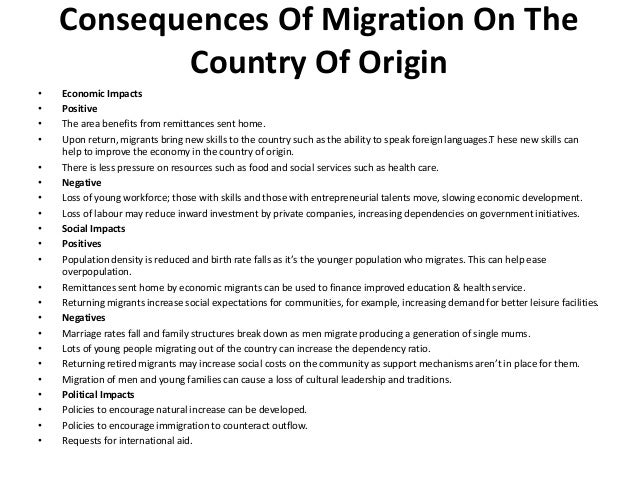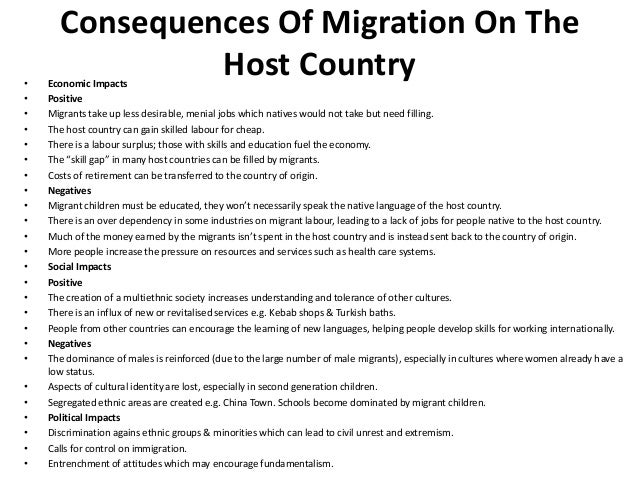Movement responses - migration
Why Do People Migrate? (from wikifoundry)
People move for a variety of reasons. They consider the advantages and disadvantages of staying versus moving, as well as factors such as distance, travel costs, travel time, modes of transportation, terrain, and cultural barriers.Push Factors: Reasons for emigrating (leaving a place) because of a difficulty (such as a food shortage, war, flood, etc.).
Pull Factors: Reasons for immigrating (moving into a place) because of something desirable (such as a nicer climate, better food supply, freedom, etc.). Several types of push and pull factors may influence people in their movements (sometimes at the same time), including:
1. Environmental (e.g., climate, natural disasters)
2. Political (e.g., war)
3. Economic (e.g., work)
4. Cultural (e.g., religious freedom, education)
Place Utility:
The desirability of a place based on its social, economic, or environmental situation, often used to compare the value of living in different locations. An individual’s idea of place utility may or may not reflect the actual conditions of that location.
Intervening Opportunities: Opportunities nearby are usually considered more attractive than equal or slightly better opportunities farther away, so migrants tend to settle in a location closer to their point of origin if other factors are equal.
Distance Decay: As distance from a given location increases, understanding of that location decreases. People are more likely to settle in a (closer) place about which they have more knowledge than in a (farther) place about which they know and understand little.
Source: http://biseco1.wikifoundry.com/page/Essential+question+one+%3A+Types+of+migration
Types of migration

Source: http://gsekkes.com/Population%20Geography.htm
Theories of migration
Ernest Ravenstein’s

Source: https://prezi.com/xr3xkahybqz0/influential-geographer-ernst-georg-ravenstein/
Zipf's
George Zipf (1946) tried to explain urban-to-urban migration by the principle of least effort. According to Zipf's theory, the number of migrants from one city to another is a function of the distance separating the cities, since the effort and cost required to cover greater distances would increase with the distance traveled. Traditionally, geographers recognize that the "friction of distance" acts on human movements, meaning that the frequency of these movements decreases with increasing distance. This relationship is known as distance-decay or inverse-distance relationships.

Source: http://biseco1.wikifoundry.com/page/Essential+question+one+%3A+Types+of+migration
Everett Lee's
The flow of migrants between two places may not totally develop if intervening obstacles exist between them. The number of migrants is directly proportional to the number of opportunities at a given place and inversely proportional to the number of intervening obstacles. (One may also think of intervening obstacles as intervening opportunities; that is, the presence of other places between an origin and destination point to which one could migrate.) Therefore, the volume of migration from one place to another is associated not only with the distance between places and number of people in the two places, but also with the number of opportunities or obstacles between each place. This is especially true in labor migration.

Source: http://biseco1.wikifoundry.com/page/Essential+question+one+%3A+Types+of+migration
Impacts of migration


Source: http://www.slideshare.net/brittzyxx/migration-revision-a-level


Source: http://www.slideshare.net/brittzyxx/migration-revision-a-level


Source: http://www.slideshare.net/brittzyxx/migration-revision-a-level

Source: https://environmentalmigration.iom.int/infographics
Refugees


Source: http://www.slideshare.net/geographyalltheway/ib-geography-population-afghanistan-refugee-case-study

No comments:
Post a Comment